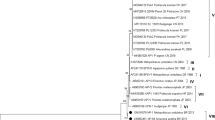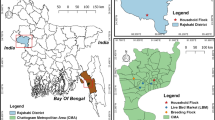Abstract
Psittacine beak and feather disease (PBFD) is characterised by degenerative feather, feather dystrophy, and beak deformity. Sometimes acute forms can lead to fatal cases in nestlings. The worldwide distribution of this disease affects numerous species of parrots with an average prevalence of 40%, including in Taiwan. The pathogen of PBFD is beak and feather disease virus (BFDV), which is a single-stranded circular DNA virus, circovirus. To date, hemagglutination and PCR assays have been routinely used to detect this virus. In this study, both the replication-associated protein (Rep) and the structural capsid protein (Cap) were expressed and then used as antigens for the production of monoclonal antibodies. Conserved epitopes recognised by the anti-Cap and anti-Rep monoclonal antibodies were determined to be NFEDYRI and LSALKKM, respectively. Clinical samples collected from different species of parrots were tested by hemagglutination, PCR, and anti-Cap antigen-capture ELISA assays and the positive rates were the same at 49%. Thus, this anti-Cap antigen-capture ELISA is able to be used for the rapid identification of BFDV-infected birds in a non-invasive manner.


Similar content being viewed by others
References
Albertyn J, Tajbhai KM, Bragg RR (2004) Psittacine beak and feather disease virus in budgerigars and ring-neck parakeets in South Africa. Ond J Vet Res 71:29–34
Rahaus M, Wolff MH (2003) Psittacine beak and feather disease: a first survey of the distribution of beak and feather disease virus inside the population of captive psittacine birds in Germany. J Vet Med 50:368–371
Doneley RJT (2003) Acute beak and feather disease in juvenile African Grey parrots-an uncommon presentation of a common disease. Aust Vet J 81:206–207
Shearer PL, Bonne N, Clark P, Sharp M, Raidal SR (2008) Development and applications of a monoclonal antibody to a recombinant beak and feather disease virus (BFDV) capsid protein. J Virol Methods 147:206–212
Tood D (2000) Circoviruses: immunosuppressive threats to avian species: a review. Avian Pathol 29:373–394
Ritchie BW, Niagro FD, Lukert PD, Steffens WL, Latimer KS (1989) Characterization a new virus from cockatoos with psittacine beak and feather disease. Virology 171:83–88
Raidal SR, McElena CL, Cross GM (1993) Seroprevalence of psittacine beak and feather disease in wild psittacine birds in New South Wales. Aust Vet J 70:137–139
Huang SW, Chiang YC, Chin CY, Tang PC, Liu PC, Wang CY (2016) The phylogenetic and recombinational analysis of beak and feather disease virus Taiwan isolates. Arch Virol 161:2969–2988
Shearer PL, Bonne N, Clark P, Sharp M, Raidal SR (2008) Beak and feather disease virus infection in cockatiels (Nymphicus hollandicus). Avian Pathol 37:75–81
Raidal SR, Sabine M, Cross GM (1993) Laboratory diagnosis of psittacine beak and feather disease by haemagglutination and haemagglutination inhibition. Aust Vet J 70:133–137
Shearer PL, Sharp M, Bonne N, Clark P, Raidal SR (2009) A blocking ELISA for the detection of antibodies to psittacine beak and feather disease virus (BFDV). J Virol Methods 158:136–140
Huang SW, Liu HP, Chen JK, Shien YW, Wong ML, Wang CY (2016) Dual ATPase and GTPase activity of the replication-associated protein (Rep) of beak and feather disease virus. Virus Res 213:149–161
Fukushi S, Nakauchi M, Mizutni T, Saijo M, Kurane I, Morikawa S (2012) Antigen-capture ELISA for the detection of Rift Valley fever virus nucleoprotein using new monoclonal antibodies. J Virol Methods 180:68–74
Niesters HGM, Bleumink-Pluym NMC, Osterhaus ADME, Horzinek MS, Van der Zeijst BAM (1987) Epitopes on the peplomer protein of infectious bronchitis virus strain M41 as defined by monoclonal antibodies. Virology 161:511–519
Jiang L, Tang YX, Yin Y, Fang DY, Zhou JM, Jiang LF (2010) Selection and identification of B-cell epitope on NS1 protein of dengue virus type 2. Virus Res 150:49–55
Johne R, Raue R, Grund C, Kaleta EF, Muller H (2004) Recombinant expression of a truncated capsid protein of beak and feather disease virus and its application in serological test. Avian Pathol 33:328–336
Ikegami T, Niikura M, Sajo M, Miranda ME, Calaor AB, Hernandez M, Acosta LP, Manalo DL, Kurane I, Yoshikawa Y, Morikawa S (2003) Antigen capture enzyme-linked immunosorbent assay for specific detection of Reston Ebola virus nucleoprotein. Clin Diagn Lab Immunol 10:552–557
Sandvick T, Krogsrud J (1995) Evaluation of an antigen-capture ELISA for detection ofbovine viral diarrhea virus in cattle blood samples. J Vet Diagn Invest 7:65–71
Acknowledgements
This study was supported by grants from the Ministry of Science and Technology, Taiwan (MOST 105-2313-B-005-030 and MOST 103-2313-B-005-039) and RD106015 from Chang Bing Show Chwan Memorial Hospital. We thank Dr. Kirby for the editing of this manuscript.
Author information
Authors and Affiliations
Corresponding author
Ethics declarations
All authors declare no conflict of interest. All procedures performed in this study involving animals were approved under a permit issued by the Animal Ethics Committee of the National Chung Hsing University, Taiwan.
Additional information
Handling Editor: Sheela Ramamoorthy.
Rights and permissions
About this article
Cite this article
Ho, CF., Huang, SW., Chan, KW. et al. Development of an antigen-capture ELISA for beak and feather disease virus. Arch Virol 163, 145–151 (2018). https://doi.org/10.1007/s00705-017-3596-6
Received:
Accepted:
Published:
Issue Date:
DOI: https://doi.org/10.1007/s00705-017-3596-6




